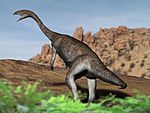Portland Formation facts for kids
Quick facts for kids Portland FormationStratigraphic range: Hettangian-Sinemurian ~199–195Ma |
|
|---|---|
| Type | Geological formation |
| Unit of | Newark Supergroup |
| Sub-units | Turners Falls Sandstone & Mount Toby Formation |
| Lithology | |
| Primary | Sandstone |
| Other | Mudstone, siltstone, limestone |
| Location | |
| Coordinates | 42°18′N 72°30′W / 42.3°N 72.5°W |
| Approximate paleocoordinates | 24°00′N 18°36′W / 24.0°N 18.6°W |
| Region | Connecticut, Massachusetts |
| Country | |
| Extent | Deerfield & Hartford Basins |
The Portland Formation is a huge set of rock layers found in Connecticut and Massachusetts, in the northeastern United States. These rocks were formed a very long time ago, during the Early Jurassic period. That's about 199 to 195 million years ago!
Most of the Portland Formation is made of sandstone. This sandstone was laid down by ancient lakes and rivers. The older parts of the formation were formed in lakes. The younger parts were created by the floodplains of a large river.
These rock layers are incredibly thick, over 4 kilometres (2.5 mi) in total. They formed over about 4 million years. This time period stretches from the Hettangian age to the Sinemurian age.
In 2016, a group of scientists led by Robert E. Weems suggested a new way to classify the Portland Formation. They thought it should be called the Portland Group instead. This would make it part of an even larger rock unit called the Newark Supergroup. Scientists often update how they name and group rock layers as they learn more!
Ancient Life: Dinosaurs and More!
Scientists have found many signs of ancient life in the Portland Formation. These include fossilized dinosaur poop, called coprolites, found in Massachusetts. They have also found many dinosaur footprints!
Dinosaur Footprints
- Footprints of Ornithischian dinosaurs have been found in Massachusetts and Connecticut. Ornithischians were plant-eating dinosaurs.
- Footprints of Theropod dinosaurs have also been found in both states. Theropods were meat-eating dinosaurs, like Tyrannosaurus rex.
- Footprints of Prosauropod dinosaurs are present too. Prosauropods were early, long-necked dinosaurs.
Dinosaur Fossils
Scientists have found actual dinosaur bones in the Portland Formation. Here are some of the dinosaurs discovered:
| Dinosaurs | ||||||
|---|---|---|---|---|---|---|
| Genus | Species | Location | What Was Found | Notes | Images | |
| Anchisaurus | A. polyzelus |
|
Bones | One of the earliest known dinosaurs from North America. | ||
| Podokesaurus | P. holyokensis | Connecticut | Part of a skeleton | Sadly, all known remains of this species have been destroyed. | ||



